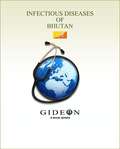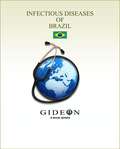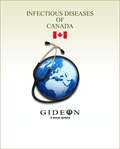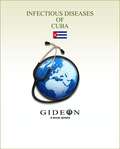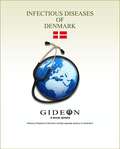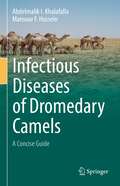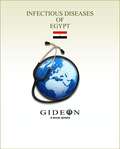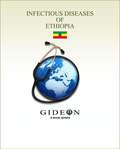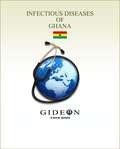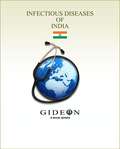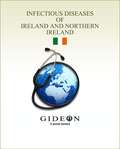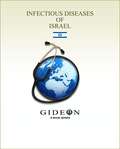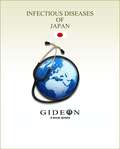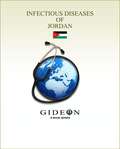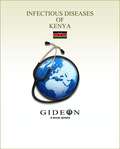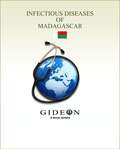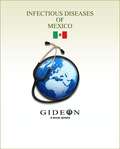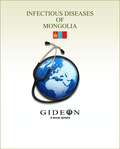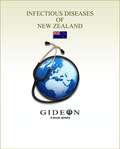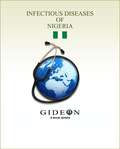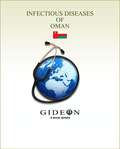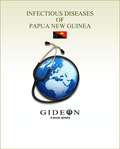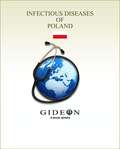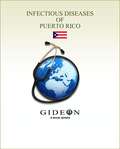- Table View
- List View
Infectious Diseases of Bhutan 2010 edition
by Dr Stephen Berger Gideon InformaticsInfectious Diseases of Bhutan is one in a series of GIDEON ebooks which summarize the status of individual infectious diseases, in every country of the world. Data are based on the GIDEON web application (www.gideononline.com) which relies on standard text books, peer-review journals, Health Ministry reports and ProMED, supplemented by an ongoing search of the medical literature. Chapters are arranged alphabetically, by disease name. Each section is divided into four sections: 1. Descriptive epidemiology2. Summary of clinical features3. Status of the disease in Bhutan4. References There are 347 generic infectious diseases in the world today. 191 of these are endemic, or potentially endemic, to Bhutan. A number of other diseases are not relevant to Bhutan and have not been included in this book. In addition to endemic diseases, all published data regarding imported diseases and infection among expatriates from Bhutan are included.
Infectious Diseases of Brazil 2010 edition
by Dr Stephen Berger Gideon InformaticsInfectious Diseases of Brazil is one in a series of GIDEON ebooks which summarize the status of individual infectious diseases, in every country of the world. Data are based on the GIDEON web application (www.gideononline.com) which relies on standard text books, peer-review journals, Health Ministry reports and ProMED, supplemented by an ongoing search of the medical literature. Chapters are arranged alphabetically, by disease name. Each section is divided into four sections: 1. Descriptive epidemiology2. Summary of clinical features3. Status of the disease in Brazil4. References There are 347 generic infectious diseases in the world today. 250 of these are endemic, or potentially endemic, to Brazil. A number of other diseases are not relevant to Brazil and have not been included in this book. In addition to endemic diseases, all published data regarding imported diseases and infection among expatriates from Brazil are included.
Infectious Diseases of Canada 2010 edition
by Dr Stephen Berger Gideon InformaticsInfectious Diseases of Canada is one in a series of GIDEON ebooks which summarize the status of individual infectious diseases, in every country of the world. Data are based on the GIDEON web application (www.gideononline.com) which relies on standard text books, peer-review journals, Health Ministry reports and ProMED, supplemented by an ongoing search of the medical literature. Chapters are arranged alphabetically, by disease name. Each section is divided into four sections: 1. Descriptive epidemiology2. Summary of clinical features3. Status of the disease in Canada4. References There are 347 generic infectious diseases in the world today. 214 of these are endemic, or potentially endemic, to Canada. A number of other diseases are not relevant to Canada and have not been included in this book. In addition to endemic diseases, all published data regarding imported diseases and infection among expatriates from Canada are included.
Infectious Diseases of Cuba 2010 edition
by Dr Stephen Berger Gideon InformaticsInfectious Diseases of Cuba is one in a series of GIDEON ebooks which summarize the status of individual infectious diseases, in every country of the world. Data are based on the GIDEON web application (www.gideononline.com) which relies on standard text books, peer-review journals, Health Ministry reports and ProMED, supplemented by an ongoing search of the medical literature. Chapters are arranged alphabetically, by disease name. Each section is divided into four sections: 1. Descriptive epidemiology2. Summary of clinical features3. Status of the disease in Cuba4. References There are 347 generic infectious diseases in the world today. 198 of these are endemic, or potentially endemic, to Cuba. A number of other diseases are not relevant to Cuba and have not been included in this book. In addition to endemic diseases, all published data regarding imported diseases and infection among expatriates from Cuba are included.
Infectious Diseases of Denmark 2010 edition
by Dr Stephen Berger Gideon InformaticsInfectious Diseases of Denmark is one in a series of GIDEON ebooks which summarize the status of individual infectious diseases, in every country of the world. Data are based on the GIDEON web application (www.gideononline.com) which relies on standard text books, peer-review journals, Health Ministry reports and ProMED, supplemented by an ongoing search of the medical literature. Chapters are arranged alphabetically, by disease name. Each section is divided into four sections: 1. Descriptive epidemiology2. Summary of clinical features3. Status of the disease in Denmark4. References There are 347 generic infectious diseases in the world today. 191 of these are endemic, or potentially endemic, to Denmark. A number of other diseases are not relevant to Denmark and have not been included in this book. Denmark disease notes include separate sections on Greenland. In addition to endemic diseases, all published data regarding imported diseases and infection among expatriates from Denmark are included.
Infectious Diseases of Dromedary Camels: A Concise Guide
by Abdelmalik I. Khalafalla Mansour F. HusseinThis book serves as a comprehensive yet concise reference guide reviewing the latest knowledge on bacterial, viral, fungal and parasitic infectious diseases of old world dromedary camels. Pathogen etiology, clinical manifestations and diagnostic techniques are provided for each pathogen and disease prevention and treatment strategies are discussed.Despite a steady increase in camel husbandry worldwide, the pathologies of camel diseases are still relatively under investigated in comparison to other livestock and companion animals. With an ongoing worldwide prevalence increase, infectious diseases are a constant threat to animal and human health. In recent years dromedary camels have become a focus of increasing public health interest since they have been considered the direct source of zoonotic transmission of MERS-CoV to humans. Along these lines, the book covers topics related to zoonotic infections associated with camels.This book offers a valuable source of information for veterinary clinicians, researchers, graduate students, veterinary technicians and interested laymen.
Infectious Diseases of Egypt 2010 edition
by Dr Stephen Berger Gideon InformaticsInfectious Diseases of Egypt is one in a series of GIDEON ebooks which summarize the status of individual infectious diseases, in every country of the world. Data are based on the GIDEON web application (www.gideononline.com) which relies on standard text books, peer-review journals, Health Ministry reports and ProMED, supplemented by an ongoing search of the medical literature. Chapters are arranged alphabetically, by disease name. Each section is divided into four sections: 1. Descriptive epidemiology2. Summary of clinical features3. Status of the disease in Egypt4. References There are 347 generic infectious diseases in the world today. 220 of these are endemic, or potentially endemic, to Egypt. A number of other diseases are not relevant to Egypt and have not been included in this book. In addition to endemic diseases, all published data regarding imported diseases and infection among expatriates from Egypt are included.
Infectious Diseases of Ethiopia 2010 edition
by Dr Stephen Berger Gideon InformaticsInfectious Diseases of Ethiopia is one in a series of GIDEON ebooks which summarize the status of individual infectious diseases, in every country of the world. Data are based on the GIDEON web application (www.gideononline.com) which relies on standard text books, peer-review journals, Health Ministry reports and ProMED, supplemented by an ongoing search of the medical literature. Chapters are arranged alphabetically, by disease name. Each section is divided into four sections: 1. Descriptive epidemiology2. Summary of clinical features3. Status of the disease in Ethiopia4. References There are 347 generic infectious diseases in the world today. 224 of these are endemic, or potentially endemic, to Ethiopia. A number of other diseases are not relevant to Ethiopia and have not been included in this book. In addition to endemic diseases, all published data regarding imported diseases and infection among expatriates from Ethiopia are included.
Infectious Diseases of Ghana 2010 edition
by Dr Stephen Berger Gideon InformaticsInfectious Diseases of Ghana is one in a series of GIDEON ebooks which summarize the status of individual infectious diseases, in every country of the world. Data are based on the GIDEON web application (www.gideononline.com) which relies on standard text books, peer-review journals, Health Ministry reports and ProMED, supplemented by an ongoing search of the medical literature. Chapters are arranged alphabetically, by disease name. Each section is divided into four sections: 1. Descriptive epidemiology2. Summary of clinical features3. Status of the disease in Ghana4. References There are 347 generic infectious diseases in the world today. 219 of these are endemic, or potentially endemic, to Ghana. A number of other diseases are not relevant to Ghana and have not been included in this book. In addition to endemic diseases, all published data regarding imported diseases and infection among expatriates from Ghana are included.
Infectious Diseases of Hong Kong 2010 edition
by Dr Stephen Berger Gideon InformaticsInfectious Diseases of Hong Kong is one in a series of GIDEON ebooks which summarize the status of individual infectious diseases, in every country of the world. Data are based on the GIDEON web application (www.gideononline.com) which relies on standard text books, peer-review journals, Health Ministry reports and ProMED, supplemented by an ongoing search of the medical literature. Chapters are arranged alphabetically, by disease name. Each section is divided into four sections: 1. Descriptive epidemiology2. Summary of clinical features3. Status of the disease in Hong Kong4. References There are 347 generic infectious diseases in the world today. 197 of these are endemic, or potentially endemic, to Hong Kong. A number of other diseases are not relevant to Hong Kong and have not been included in this book. In addition to endemic diseases, all published data regarding imported diseases and infection among expatriates from Hong Kong are included.
Infectious Diseases of India 2010 edition
by Dr Stephen Berger Gideon InformaticsInfectious Diseases of India is one in a series of GIDEON ebooks which summarize the status of individual infectious diseases, in every country of the world. Data are based on the GIDEON web application (www.gideononline.com) which relies on standard text books, peer-review journals, Health Ministry reports and ProMED, supplemented by an ongoing search of the medical literature. Chapters are arranged alphabetically, by disease name. Each section is divided into four sections: 1. Descriptive epidemiology2. Summary of clinical features3. Status of the disease in India4. References There are 347 generic infectious diseases in the world today. 245 of these are endemic, or potentially endemic, to India. A number of other diseases are not relevant to India and have not been included in this book. In addition to endemic diseases, all published data regarding imported diseases and infection among expatriates from India are included.
Infectious Diseases of Ireland and Northern Ireland 2010 edition
by Dr Stephen Berger Gideon InformaticsInfectious Diseases of Ireland and Northern Ireland is one in a series of GIDEON ebooks which summarize the status of individual infectious diseases, in every country of the world. Data are based on the GIDEON web application (www.gideononline.com) which relies on standard text books, peer-review journals, Health Ministry reports and ProMED, supplemented by an ongoing search of the medical literature. Chapters are arranged alphabetically, by disease name. Each section is divided into four sections: 1. Descriptive epidemiology2. Summary of clinical features3. Status of the disease in Ireland and Northern Ireland4. References There are 347 generic infectious diseases in the world today. 189 of these are endemic, or potentially endemic, to Ireland and Northern Ireland. A number of other diseases are not relevant to Ireland and Northern Ireland and have not been included in this book. In addition to endemic diseases, all published data regarding imported diseases and infection among expatriates from Ireland and Northern Ireland are included.
Infectious Diseases of Israel 2010 edition
by Dr Stephen Berger Gideon InformaticsInfectious Diseases of Israel is one in a series of GIDEON ebooks which summarize the status of individual infectious diseases, in every country of the world. Data are based on the GIDEON web application (www.gideononline.com) which relies on standard text books, peer-review journals, Health Ministry reports and ProMED, supplemented by an ongoing search of the medical literature. Chapters are arranged alphabetically, by disease name. Each section is divided into four sections: 1. Descriptive epidemiology2. Summary of clinical features3. Status of the disease in Israel4. References There are 347 generic infectious diseases in the world today. 200 of these are endemic, or potentially endemic, to Israel. A number of other diseases are not relevant to Israel and have not been included in this book. In addition to endemic diseases, all published data regarding imported diseases and infection among expatriates from Israel are included.
Infectious Diseases of Japan 2010 edition
by Dr Stephen Berger Gideon InformaticsInfectious Diseases of Japan is one in a series of GIDEON ebooks which summarize the status of individual infectious diseases, in every country of the world. Data are based on the GIDEON web application (www.gideononline.com) which relies on standard text books, peer-review journals, Health Ministry reports and ProMED, supplemented by an ongoing search of the medical literature. Chapters are arranged alphabetically, by disease name. Each section is divided into four sections: 1. Descriptive epidemiology2. Summary of clinical features3. Status of the disease in Japan4. References There are 347 generic infectious diseases in the world today. 215 of these are endemic, or potentially endemic, to Japan. A number of other diseases are not relevant to Japan and have not been included in this book. In addition to endemic diseases, all published data regarding imported diseases and infection among expatriates from Japan are included.
Infectious Diseases of Jordan 2010 edition
by Dr Stephen Berger Gideon InformaticsInfectious Diseases of Jordan is one in a series of GIDEON ebooks which summarize the status of individual infectious diseases, in every country of the world. Data are based on the GIDEON web application (www.gideononline.com) which relies on standard text books, peer-review journals, Health Ministry reports and ProMED, supplemented by an ongoing search of the medical literature. Chapters are arranged alphabetically, by disease name. Each section is divided into four sections: 1. Descriptive epidemiology2. Summary of clinical features3. Status of the disease in Jordan4. References There are 347 generic infectious diseases in the world today. 197 of these are endemic, or potentially endemic, to Jordan. A number of other diseases are not relevant to Jordan and have not been included in this book. In addition to endemic diseases, all published data regarding imported diseases and infection among expatriates from Jordan are included.
Infectious Diseases of Kenya 2010 edition
by Dr Stephen Berger Gideon InformaticsInfectious Diseases of Kenya is one in a series of GIDEON ebooks which summarize the status of individual infectious diseases, in every country of the world. Data are based on the GIDEON web application (www.gideononline.com) which relies on standard text books, peer-review journals, Health Ministry reports and ProMED, supplemented by an ongoing search of the medical literature. Chapters are arranged alphabetically, by disease name. Each section is divided into four sections: 1. Descriptive epidemiology2. Summary of clinical features3. Status of the disease in Kenya4. References There are 347 generic infectious diseases in the world today. 232 of these are endemic, or potentially endemic, to Kenya. A number of other diseases are not relevant to Kenya and have not been included in this book. In addition to endemic diseases, all published data regarding imported diseases and infection among expatriates from Kenya are included.
Infectious Diseases of Madagascar 2010 edition
by Dr Stephen Berger Gideon InformaticsInfectious Diseases of Madagascar is one in a series of GIDEON ebooks which summarize the status of individual infectious diseases, in every country of the world. Data are based on the GIDEON web application (www.gideononline.com) which relies on standard text books, peer-review journals, Health Ministry reports and ProMED, supplemented by an ongoing search of the medical literature. Chapters are arranged alphabetically, by disease name. Each section is divided into four sections: 1. Descriptive epidemiology2. Summary of clinical features3. Status of the disease in Madagascar4. References There are 347 generic infectious diseases in the world today. 213 of these are endemic, or potentially endemic, to Madagascar. A number of other diseases are not relevant to Madagascar and have not been included in this book. In addition to endemic diseases, all published data regarding imported diseases and infection among expatriates from Madagascar are included.
Infectious Diseases of Mexico 2010 edition
by Dr Stephen Berger Gideon InformaticsInfectious Diseases of Mexico is one in a series of GIDEON ebooks which summarize the status of individual infectious diseases, in every country of the world. Data are based on the GIDEON web application (www.gideononline.com) which relies on standard text books, peer-review journals, Health Ministry reports and ProMED, supplemented by an ongoing search of the medical literature. Chapters are arranged alphabetically, by disease name. Each section is divided into four sections: 1. Descriptive epidemiology2. Summary of clinical features3. Status of the disease in Mexico4. References There are 347 generic infectious diseases in the world today. 233 of these are endemic, or potentially endemic, to Mexico. A number of other diseases are not relevant to Mexico and have not been included in this book. In addition to endemic diseases, all published data regarding imported diseases and infection among expatriates from Mexico are included.
Infectious Diseases of Mongolia 2010 edition
by Dr Stephen Berger Gideon InformaticsInfectious Diseases of Mongolia is one in a series of GIDEON ebooks which summarize the status of individual infectious diseases, in every country of the world. Data are based on the GIDEON web application (www.gideononline.com) which relies on standard text books, peer-review journals, Health Ministry reports and ProMED, supplemented by an ongoing search of the medical literature. Chapters are arranged alphabetically, by disease name. Each section is divided into four sections: 1. Descriptive epidemiology2. Summary of clinical features3. Status of the disease in Mongolia4. References There are 347 generic infectious diseases in the world today. 200 of these are endemic, or potentially endemic, to Mongolia. A number of other diseases are not relevant to Mongolia and have not been included in this book. In addition to endemic diseases, all published data regarding imported diseases and infection among expatriates from Mongolia are included.
Infectious Diseases of New Zealand 2010 edition
by Dr Stephen Berger Gideon InformaticsInfectious Diseases of New Zealand is one in a series of GIDEON ebooks which summarize the status of individual infectious diseases, in every country of the world. Data are based on the GIDEON web application (www.gideononline.com) which relies on standard text books, peer-review journals, Health Ministry reports and ProMED, supplemented by an ongoing search of the medical literature. Chapters are arranged alphabetically, by disease name. Each section is divided into four sections: 1. Descriptive epidemiology2. Summary of clinical features3. Status of the disease in New Zealand4. References There are 347 generic infectious diseases in the world today. 188 of these are endemic, or potentially endemic, to New Zealand. A number of other diseases are not relevant to New Zealand and have not been included in this book. In addition to endemic diseases, all published data regarding imported diseases and infection among expatriates from New Zealand are included.
Infectious Diseases of Nigeria 2010 edition
by Dr Stephen Berger Gideon InformaticsInfectious Diseases of Nigeria is one in a series of GIDEON ebooks which summarize the status of individual infectious diseases, in every country of the world. Data are based on the GIDEON web application (www.gideononline.com) which relies on standard text books, peer-review journals, Health Ministry reports and ProMED, supplemented by an ongoing search of the medical literature. Chapters are arranged alphabetically, by disease name. Each section is divided into four sections: 1. Descriptive epidemiology2. Summary of clinical features3. Status of the disease in Nigeria4. References There are 347 generic infectious diseases in the world today. 239 of these are endemic, or potentially endemic, to Nigeria. A number of other diseases are not relevant to Nigeria and have not been included in this book. In addition to endemic diseases, all published data regarding imported diseases and infection among expatriates from Nigeria are included.
Infectious Diseases of Oman 2010 edition
by Dr Stephen Berger Gideon InformaticsInfectious Diseases of Oman is one in a series of GIDEON ebooks which summarize the status of individual infectious diseases, in every country of the world. Data are based on the GIDEON web application (www.gideononline.com) which relies on standard text books, peer-review journals, Health Ministry reports and ProMED, supplemented by an ongoing search of the medical literature. Chapters are arranged alphabetically, by disease name. Each section is divided into four sections: 1. Descriptive epidemiology2. Summary of clinical features3. Status of the disease in Oman4. References There are 347 generic infectious diseases in the world today. 197 of these are endemic, or potentially endemic, to Oman. A number of other diseases are not relevant to Oman and have not been included in this book. In addition to endemic diseases, all published data regarding imported diseases and infection among expatriates from Oman are included.
Infectious Diseases of Papua New Guinea 2010 edition
by Dr Stephen Berger Gideon InformaticsInfectious Diseases of Papua New Guinea is one in a series of GIDEON ebooks which summarize the status of individual infectious diseases, in every country of the world. Data are based on the GIDEON web application (www.gideononline.com) which relies on standard text books, peer-review journals, Health Ministry reports and ProMED, supplemented by an ongoing search of the medical literature. Chapters are arranged alphabetically, by disease name. Each section is divided into four sections: 1. Descriptive epidemiology2. Summary of clinical features3. Status of the disease in Papua New Guinea4. References There are 347 generic infectious diseases in the world today. 206 of these are endemic, or potentially endemic, to Papua New Guinea. A number of other diseases are not relevant to Papua New Guinea and have not been included in this book. In addition to endemic diseases, all published data regarding imported diseases and infection among expatriates from Papua New Guinea are included.
Infectious Diseases of Poland 2010 edition
by Dr Stephen Berger Gideon InformaticsInfectious Diseases of Poland is one in a series of GIDEON ebooks which summarize the status of individual infectious diseases, in every country of the world. Data are based on the GIDEON web application (www.gideononline.com) which relies on standard text books, peer-review journals, Health Ministry reports and ProMED, supplemented by an ongoing search of the medical literature. Chapters are arranged alphabetically, by disease name. Each section is divided into four sections: 1. Descriptive epidemiology2. Summary of clinical features3. Status of the disease in Poland4. References There are 347 generic infectious diseases in the world today. 199 of these are endemic, or potentially endemic, to Poland. A number of other diseases are not relevant to Poland and have not been included in this book. In addition to endemic diseases, all published data regarding imported diseases and infection among expatriates from Poland are included.
Infectious Diseases of Puerto Rico 2010 edition
by Dr Stephen Berger Gideon InformaticsInfectious Diseases of Puerto Rico is one in a series of GIDEON ebooks which summarize the status of individual infectious diseases, in every country of the world. Data are based on the GIDEON web application (www.gideononline.com) which relies on standard text books, peer-review journals, Health Ministry reports and ProMED, supplemented by an ongoing search of the medical literature. Chapters are arranged alphabetically, by disease name. Each section is divided into four sections: 1. Descriptive epidemiology2. Summary of clinical features3. Status of the disease in Puerto Rico4. References There are 347 generic infectious diseases in the world today. 197 of these are endemic, or potentially endemic, to Puerto Rico. A number of other diseases are not relevant to Puerto Rico and have not been included in this book. In addition to endemic diseases, all published data regarding imported diseases and infection among expatriates from Puerto Rico are included.
